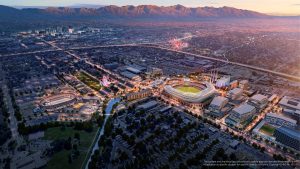Baseball has suddenly become an important part of the future of an emerging Wasatch Front, and the area ought to embrace it.
This new benefit of rapid growth began last summer when a group of prominent Utahns, led by the Larry H. Miller Company, launched a serious effort to acquire a major league baseball expansion franchise. The group went so far as to identify a stadium site along North Temple near downtown. Now, Utah lawmakers appear poised to support that plan with a bill that is likely to contain funding in the form of tax increment financing — a device that would capture the growth in property tax payments in a redeveloped area and use it to retire stadium construction loans.
The realization of an expansion team in a new big league stadium may take years to materialize. However, fans may not have to wait that long to watch big leaguers play in person.
The Oakland A’s of the American League are moving to Las Vegas, but that move cannot be completed until a new stadium, projected to be ready by 2028, is completed. In the meantime, team officials have met with Miller Company officials and toured the site of a new minor league stadium and commercial complex under construction in South Jordan’s Daybreak neighborhood. This may end up as an interim home for the team.
If this temporary solution becomes a reality, it would be a welcomed trial period for Utahns anxious to have major league baseball in their midst permanently.
Utahns should not need to become fans of the A’s in order to support the idea of big league baseball through their attendance at games. The Miller Company’s plans are for a small stadium in Daybreak, with a capacity of about 7,500, but officials told the Deseret News that could be expanded to 12,000 to make it more accommodating to a big league team.
Last year, the A’s averaged 10,275 fans per game, during a year in which many fans were disappointed by the inevitable relocation of the team. Utahns ought to be able to better that by selling out every game in a small stadium, demonstrating their ability to support a team of their own.
Utah led the nation in growth during the decade of the teens. Some longtime residents may be surprised to learn how that has put the Wasatch Front into a category of major cities. The combined statistical area of Salt Lake City, Provo and Ogden now has an estimated population of nearly 2.8 million people, according to the Census Bureau.
It now ranks as the 22nd largest combined statistical area metropolis in the nation, ahead of existing major league cities such as Pittsburgh, Kansas City, Cincinnati and Milwaukee.
The Gardner Institute at the University of Utah estimates that the state’s population will grow to 5.5 million by 2060. Clearly, the state, and the Wasatch Front, are changing. This would be an opportunity to flex this newfound population muscle for the nation.
Many economists doubt the economic benefits of adding major sports teams to a metropolitan area. They note that these tend to move entertainment dollars around, leading consumers to substitute one form of entertainment — in this case, baseball — for something else, such as a night at the movies.
This may be true, but bringing big league baseball to Utah would have the effect of enhancing the area’s reputation, legitimizing it in a way that would entice growth, giving businesses a large amenity for employees who may be asked to move here, and perhaps leading other leagues, such as the National Hockey League, to locate here, as well.
It would provide an opportunity for new entertainment spending by people who continue to move here from elsewhere.
Not many cities get a tryout on the major league level. Bringing the A’s to town, even if only for a couple of years, would change perceptions of this once-isolated Mountain West metropolis, even as it paves the way for a more permanent team in the future. We urge local leaders to do whatever it takes to make this happen.
Read the article by The Deseret News Editorial Board here.

